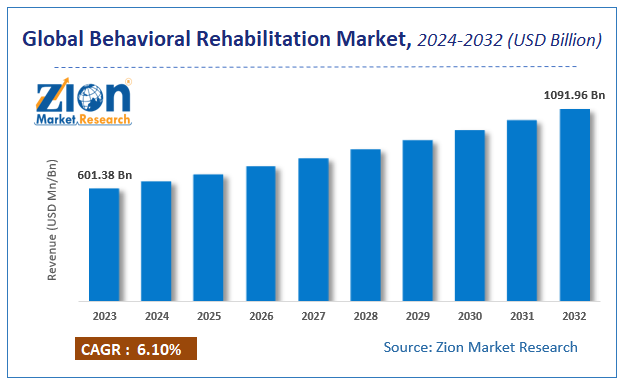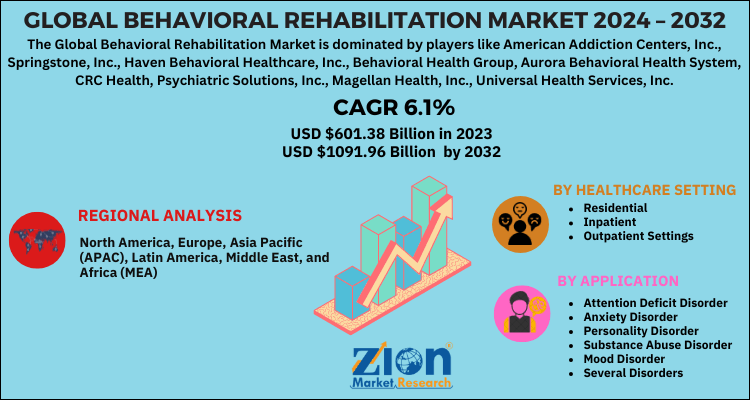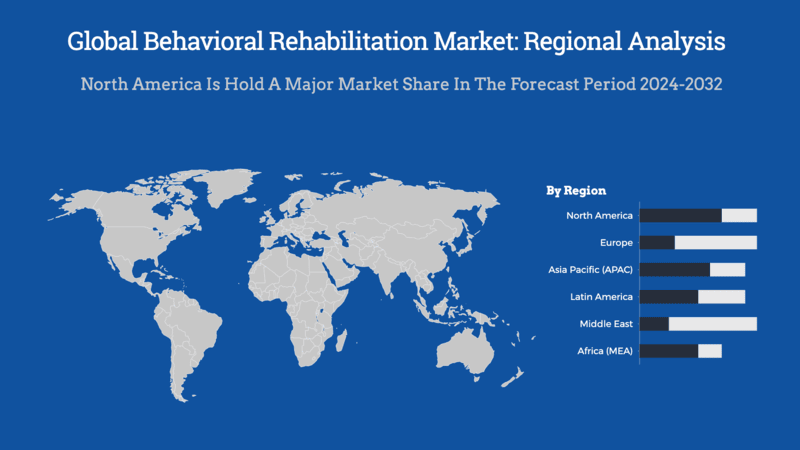Behavioral Rehabilitation Market Size, Share, Growth Report, Trends, Forecast 2032

Behavioral Rehabilitation Market By healthcare setting (residential, inpatient, and outpatient settings), application (attention deficit disorder, anxiety disorder, personality disorder, substance abuse disorder, mood disorder, and several disorders) And By Region: - Global And Regional Industry Overview, Market Intelligence, Comprehensive Analysis, Historical Data, And Forecasts, 2024-2032
| Market Size in 2023 | Market Forecast in 2032 | CAGR (in %) | Base Year |
|---|---|---|---|
| USD 601.38 Billion | USD 1091.96 Billion | 6.1% | 2023 |
Description
Global Behavioral Rehabilitation Market Insights
According to the report published by Zion Market Research, the global Behavioral Rehabilitation Market size was valued at USD 601.38 Billion in 2023 and is predicted to reach USD 1091.96 Billion by the end of 2032. The market is expected to grow with a CAGR of 6.1% during the forecast period. The report analyzes the global Behavioral Rehabilitation Market's growth drivers, restraints, and impact on demand during the forecast period. It will also help navigate and explore the arising opportunities in the Behavioral Rehabilitation industry.
Global Behavioral Rehabilitation Market: Overview
People get behavioral addiction due to several reasons and such addictions can harm their health. There are several addictions that do not go away by themselves but need high and reliable methodologies along with a set of behavioral rehabilitation for treating them. Behavioral rehabilitation activities are offered by professional individuals who understand the root cause of addiction and know several tools to overcome them. The behavioral rehabilitation process includes a multi-state affair. It is an inpatient program created by analyzing the behavioral addiction revealed by the patients, their symptoms, and their severity. The program starts with keeping the patient under close watch and far away from the elements that can trigger their addictive behavior.
Global Behavioral Rehabilitation Market: Growth Factors
The increasing prevalence of behavioral disorders along with growing awareness of several easily available therapeutic options is one of the major factors driving the growth of the global behavioral rehabilitation market. The growing government initiatives to boost the investment on innovative behavioral rehabilitation programs that can eliminate substance abuse are also providing ample thrust to the global market. The transforming perception regarding the behavioral revolution among people is a key factor raising the demand for behavioral therapies globally. The societal acceptance of behavioral disorders and people’s belief in seeking appropriate treatment is creating many lucrative growth opportunities in the global behavioral rehabilitation market in the forthcoming years. Also, the growing anxiety and depression disorders among people globally are further boosting the demand for behavioral rehabilitation therapies.
Key Insights
- As per the analysis shared by our research analyst, the global Behavioral Rehabilitation Market is estimated to grow annually at a CAGR of around 6.1% over the forecast period (2024-2032).
- In terms of revenue, the global Behavioral Rehabilitation Market size was valued at around USD 601.38 Billion in 2023 and is projected to reach USD 1091.96 Billion by 2032.
- Based on the Healthcare Setting, Outpatient services hold the largest market share, accounting for approximately 74.07% of the revenue in 2023. This dominance is attributed to factors such as lower costs, increased availability of services, and enhanced patient convenience.
- Based on the Application, Anxiety disorders represent the largest segment, with a share of around 32.18% in 2023. The high prevalence of conditions like social anxiety, phobias, and other panic disorders, coupled with a wide range of treatment options, drives this dominance.
- Based on the Region, North America leads the market, holding a revenue share of 41.92% in 2023. This leadership is due to rising awareness about mental disorders, availability of advanced treatments, favorable government initiatives, and comprehensive insurance coverage for behavioral healthcare services.
Behavioral Rehabilitation Market: Dynamics
Key Growth Drivers
The behavioral rehabilitation market is primarily driven by the rising prevalence of mental health disorders, including anxiety, depression, substance abuse, and behavioral addictions. Increased awareness about mental health issues, supported by government initiatives and non-profit organizations, has led to greater demand for rehabilitation services. Additionally, advancements in therapeutic approaches, including cognitive-behavioral therapy (CBT) and personalized treatment plans, enhance the effectiveness of rehabilitation programs. The integration of telehealth and virtual counseling platforms has further expanded access to behavioral rehabilitation, particularly in underserved and remote areas. Increasing investments in mental health infrastructure and the expansion of behavioral health facilities also contribute to market growth.
Restraints
Despite significant progress, the behavioral rehabilitation market faces several challenges, including the high cost of rehabilitation services. Many individuals, especially in low- and middle-income countries, struggle to afford long-term treatment. Limited insurance coverage for behavioral health services further restricts access to care. Additionally, the persistent stigma associated with mental health conditions discourages people from seeking help, negatively impacting market growth. The shortage of qualified mental health professionals and inadequate infrastructure in certain regions also act as barriers to the expansion of behavioral rehabilitation services.
Opportunities
Growing recognition of mental health as a critical component of overall well-being presents substantial opportunities for the behavioral rehabilitation market. Governments and private organizations are increasing investments in mental health facilities and community-based programs to meet the rising demand for care. The adoption of digital health solutions, including mobile apps and telepsychiatry, provides accessible and cost-effective rehabilitation options. Furthermore, the increasing prevalence of co-occurring disorders, where individuals experience both mental health and substance use disorders, creates a need for integrated treatment programs. Partnerships between healthcare providers, insurance companies, and technology firms can also drive innovation and expand service availability.
Challenges
One of the major challenges in the behavioral rehabilitation market is the fragmented nature of mental health care systems, which often lack coordination between different service providers. This can lead to gaps in treatment continuity and reduced patient outcomes. Regulatory and reimbursement complexities further hinder the growth of the market, as policies regarding mental health coverage vary across regions. Additionally, resistance to adopting new technologies and treatment methodologies within traditional healthcare settings can slow market advancement. Ensuring the quality and standardization of care, particularly in emerging digital platforms, remains a significant challenge for the industry.
Behavioral Rehabilitation Market: Report Scope
| Report Attributes | Report Details |
|---|---|
| Report Name | Behavioral Rehabilitation Market |
| Market Size in 2023 | USD 601.38 Billion |
| Market Forecast in 2032 | USD 1091.96 Billion |
| Growth Rate | CAGR of 6.1% |
| Number of Pages | 192 |
| Key Companies Covered | American Addiction Centers, Inc., Springstone, Inc., Haven Behavioral Healthcare, Inc., Behavioral Health Group, Aurora Behavioral Health System, CRC Health, Psychiatric Solutions, Inc., Magellan Health, Inc., Universal Health Services, Inc., and Acadia Healthcare |
| Segments Covered | By Healthcare Setting, By Application And By Region |
| Regions Covered | North America, Europe, Asia Pacific (APAC), Latin America, Middle East, and Africa (MEA) |
| Base Year | 2023 |
| Historical Year | 2018 to 2022 |
| Forecast Year | 2024 - 2032 |
| Customization Scope | Avail customized purchase options to meet your exact research needs. Request For Customization |
Global Behavioral Rehabilitation Market: Segmentation
The global behavioral rehabilitation market can be segmented into the healthcare setting, application, and region. All the segments have been analyzed based on present and future trends and the market is estimated from 2024 to 2032.
By healthcare setting, the market can be segmented into residential, inpatient, and outpatient settings. The outpatient segment accounts for the largest share in the global behavioral rehabilitation market due to the growing availability of such services at affordable prices. Moreover, the convenience offered by outpatient settings is further attributing to the growth of the segment. The outpatient treatment assists patients to stay connected with different communities and maintain healthy social interaction for faster recovery. However, the residential segment is expected to witness a significant growth rate in forthcoming years due to the growing shift in preferences of patients from inpatient to a residential setting.
By application, the market can be segmented into attention deficit disorder, anxiety disorder, personality disorder, substance abuse disorder, mood disorder, and several disorders. The anxiety disorder segment holds the largest share in the global behavioral rehabilitation market. The major anxiety disorders include phobia, social anxiety, and other panic disorders. The growing prevalence of mental disorders along with the availability of effective treatment is further fuelling the demand for anxiety disorder. Moreover, the growing awareness regarding anxiety treatment is likely to escalate the growth of the segment in the forthcoming years.
The regional segment includes the current and forecast demand for North America, Europe, Asia Pacific, Latin America, and the Middle East and Africa.
Global Behavioral Rehabilitation Market: Regional analysis
The behavioral rehabilitation market demonstrates significant regional variations, influenced by factors such as healthcare infrastructure, prevalence of behavioral disorders, government initiatives, and societal awareness.
North America
North America holds a substantial portion of the global behavioral rehabilitation market, with the U.S. playing a pivotal role. The region's advanced healthcare infrastructure, coupled with a high prevalence of mental health disorders, drives market growth. Government initiatives, such as the Affordable Care Act (ACA), mandate insurance coverage for mental health services, enhancing accessibility to rehabilitation programs. Canada's universal healthcare system also contributes to the availability of behavioral rehabilitation services.
Europe
Europe represents a significant share of the market, with countries like the United Kingdom, Germany, and France leading in behavioral rehabilitation services. Robust government support and public health initiatives have increased awareness and accessibility to mental health services. The National Health Service (NHS) in the UK, for instance, has implemented extensive mental health programs focusing on early intervention and prevention.
Asia-Pacific
The Asia-Pacific region is experiencing rapid growth in the behavioral rehabilitation market. In 2023, the market generated revenue of USD 103.4 billion and is projected to grow at a compound annual growth rate (CAGR) of 6.8% from 2024 to 2030. This growth is driven by increasing mental health awareness, rising healthcare expenditures, and government initiatives in countries such as China, Japan, and India. Notably, Thailand is expected to register the highest CAGR in the region during this period.
Latin America and Middle East & Africa
These regions are emerging markets for behavioral rehabilitation, with countries like Brazil, Mexico, the United Arab Emirates, and South Africa making strides in mental health awareness and services. Despite challenges such as limited resources and societal stigma, government efforts to improve healthcare infrastructure and public awareness are fostering market growth. For example, the UAE government has implemented policies to promote mental wellness and support behavioral rehabilitation.
Global Behavioral Rehabilitation Market: Competitive Players
Some of the significant players in the global behavioral rehabilitation market are
- American Addiction Centers Inc.
- Springstone, Inc.
- Haven Behavioral Healthcare Inc.
- Behavioral Health Group
- Aurora Behavioral Health System
- CRC Health
- Psychiatric Solutions Inc.
- Magellan Health Inc.
- Universal Health Services Inc.
- Acadia Healthcare.
The Global Behavioral Rehabilitation Market is segmented as follows:
By Healthcare Setting
- Residential
- Inpatient
- Outpatient Settings
By Application
- Attention Deficit Disorder
- Anxiety Disorder
- Personality Disorder
- Substance Abuse Disorder
- Mood Disorder
- Several Disorders
Global Behavioral Rehabilitation Market: Regional Segment Analysis
- North America
- The U.S.
- Canada
- Europe
- France
- The UK
- Spain
- Germany
- Italy
- Rest of Europe
- Asia Pacific
- China
- Japan
- India
- South Korea
- Southeast Asia
- Rest of Asia Pacific
- Latin America
- Brazil
- Mexico
- Rest of Latin America
- Middle East & Africa
- GCC
- South Africa
- Rest of Middle East & Africa
What Reports Provides
- Full in-depth analysis of the parent market
- Important changes in market dynamics
- Segmentation details of the market
- Former, on-going, and projected market analysis in terms of volume and value
- Assessment of niche industry developments
- Market share analysis
- Key strategies of major players
- Emerging segments and regional markets
- Testimonials to companies in order to fortify their foothold in the market.
Table Of Content
FrequentlyAsked Questions
The increasing prevalence of behavioral disorders along with growing awareness of several easily available therapeutic options is one of the major factors driving the growth of the global behavioral rehabilitation market. The growing government initiatives to boost the investment on innovative behavioral rehabilitation programs that can eliminate substance abuse is also providing ample thrust to the global market.
Some of the significant players in the global behavioral rehabilitation market are American Addiction Centers, Inc., Springstone, Inc., Haven Behavioral Healthcare, Inc., Behavioral Health Group, Aurora Behavioral Health System, CRC Health, Psychiatric Solutions, Inc., Magellan Health, Inc., Universal Health Services, Inc., and Acadia Healthcare.
North America accounts for the largest share in the global behavioral rehabilitation market due to the growing awareness among people regarding mental health and also the availability of advanced treatment for several mental ailments in the region. The growing government initiatives along with reimbursement policies are likely to propel the growth of the regional market in the forthcoming years.
HappyClients
Zion Market Research
Tel: +1 (302) 444-0166
USA/Canada Toll Free No.+1 (855) 465-4651
3rd Floor,
Mrunal Paradise, Opp Maharaja Hotel,
Pimple Gurav, Pune 411061,
Maharashtra, India
Phone No +91 7768 006 007, +91 7768 006 008
US OFFICE NO +1 (302) 444-0166
US/CAN TOLL FREE +1 (855) 465-4651
Email: sales@zionmarketresearch.com
We have secured system to process your transaction.
Our support available to help you 24 hours a day, five days a week.
Monday - Friday: 9AM - 6PM
Saturday - Sunday: Closed








